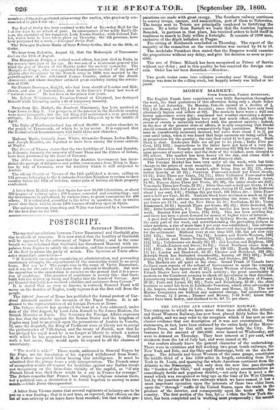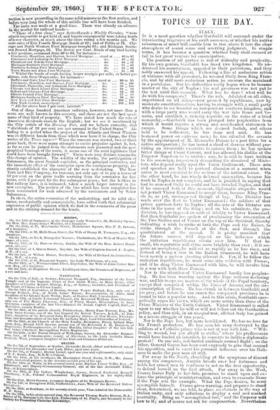THE ATLANTIC AND GREAT WESTERN RAILWAY.
Tin enterprise to which we have more than. once alluded, the Atlantic and Great Western Railway, has now been placed fairly before the Bri- tish public, and we may refer to the reception which it has met as con- clusive evidence that our description of it was not overstrained. Our statements, in fact, have been endorsed by the entire body of the Metro- politan Press, and by that still more important body the City. De- bentures to the amount of 200,0001. were issued on Wednesday, and were in demand on Thursday. They bear interest at 7 per cent, with dividends from the 1st of July last, and were issued at 80.
Our readers already know the general character of the undertaking. There were in existence and full working two great trunk railways, the New York and Erie, and the Ohio and Mississippi, both on the six-feet gauge. The Atlantic and Great Western of the same gauge, constitutes the middle third of a line 1200 miles in length, extending from New York to St. Louis, and spanning the whole American continent from the Atlantic to the Mississippi. Not only does the new line pass through the " Garden of the Ohio," and supply with railway accommodation an exceedingly fertile and populous district,—not only does it meet a de- mand which was recognized so long ago as the time of De Witt Clinton, but by the junction of the two railways which we have named, it has a most important operation upon the interests of those two older lines, upon the " through" traffics of the United States, upon the trade in the produce of the interior, and consequently upon the trade with this country. The first section of the line, lyiwithin the New York dis- trict, has been completed and is working most proapuously ; the second
section is now prooeeding in the same solid manner as the first section, and before very_long the whole of this middle line will have been finished. The issue was made at a good time. There was already an advance in the tuarket for railroad bonds-
" Those of a first class," says Satterthicaile s Weekly Circular, " were almost impossible to get hold of, and buyera consequently were taking bonds of lower character, at much above the rates ruling a few months ago. We note sales of Erie Fourth Mortgage Bonds at BO; and of Fifths at 78. Chi- cago and North Western First Mortgage brought 6.5; and Michigan South- ern Second Mortgage, 66. The Seven per Cent. Bonds of any road having a fair position, command from 80 to 90, forinstance-
Cincinnati, Hamilton, and Dayton, Second Mortgage stand at .... 8.5 to 87 Cincinnati and Indianapalis First Mortgage do. ... 80 „ 82 Cleveland and Toledo First Mortgage do. ...„ 82
Michigan Southern First Mortgage do. ... 81 „ 82
Northern Indiana First Mortgage do. 84 „ 86 Terre Haute and Alton First Mortgage o. 1 „ 84
” Whilst the bonds of roads having larger receipts per mile, or better po- sitions, rule from 90 upwards; for instance—
Buffalo and State Line First Mortgage stand at ... 90 to 95 Cincinnati, Hamilton, and Dayton, First Mortgage do. ... 96 „ 100 Cleveland, Painsville, aud Ashtabula First Mortgage do. .. , 98 „ 100 Chicago and Rock Island First Mortgage do. ... 94 „ 96
Galena and Chicago First Mortgage do. . • • 94 ,.• 96
Illinois Central First Mortgage do. 97 „ 98 Michigan Southern First Mortgage do. ... 88 „ 90 New I ork and Erie First Mortgage de. ... 103 „ 104 New York Central, no mortgage do. 102 „ 104
" All the above bear 7 per cent. interest."
Out of three hundred American railways, however, not more than a score are well known in this country, and these are not the best speci- mens of that kind of property. We have stated how much the rate of American dividends exceeds the English ; but we see it mentioned by the City article of the Morning Post, and we believe correctly, that " dividends of 20 per cent are not unusual in the 'United States." Al- luding to a period when the project of the Atlantic and Great Western was in different hands from those which now have it in charge, the City writer of the Times says—" When the concern was started, two or three years back, there were many attempts to excite prejudice against it, but, as far as can be judged from the statements now presented and the geo- graphical bearings of the route, it seems one of the most legitimate that could have been brought forward." There were very distinct reasons for this change of opinion. The solidity of the works, the participation of Salamanca, the great Spanish capitalist, as the principal contractor, and the immediate effect of the enterprise upon the contiguous property, in- stantly established the character of the new m-dertaking. The New York and Erie Company, for instance, not only agr.. ad to pay a bonus of 10 per cent on the gross traffic accruing from the connexion fur five years, with 5 per cent for the five subsequent years ; but the halders in that railway have, it is intimated, taken a much larger interest in the new enterprise. The portion of the line which has been completed has been constructed for cash advanced by the contractors and by Scher Salamanca.
In short, the entire connexion of the undertaking, and its solid cha- racter, mechanically and commercially, have called forth that substantial expression of public opinion which we find in the comments of the press and in the striking demand for the bonds.



























 Previous page
Previous page